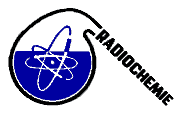Speaker
Dr
Galina Lujaniene
(Institute of Physics, Savanorių ave 231, Vilnius, LT-02300, Lithuania)
Description
Sorption–desorption behaviour of Cs, Pu and Am in the system was studied using data obtained from different sampling campaigns in the Baltic Sea and the Curonian Lagoon in 1999-2009 as well as from short- and long-term kinetic tracer experiments using natural sea or river water and bottom sediments collected in the Curonian Lagoon or the Baltic Sea. Sorption experiments were carried out with particles of various sizes from 0.2 to 50 µm. Samples of suspended particles and bottom sediments collected during these sampling campaigns were fractionated according to the size, and association of 137Cs with solid phase was studied using sequential extraction. In addition, the in situ distribution of 137Cs between water and suspended particles of various sizes was measured and expressed as Kd. Kd values for suspended particles of > 0.2 µm size ranged from 1000 to 5500 ml/g in the near shore zone of the Baltic Sea and from 1400 to 20000 ml/g in the Curonian Lagoon. The part of 137Cs bound to 0.2-1 µm particles changed from 10% in the near shore waters to about 80% in the open sea. For all studied radionuclides Cs, Pu and Am an increase in massic activities with decrease of bottom sediment particle sizes was determined. Data obtained from tracer kinetic sorption experiments with 134Cs and bottom sediment fractions of different grain size were used for finding a suitable kinetic sorption model, kinetic constants and the corresponding equilibrium Kd values. It has been found that the modelled data best conform to the mechanism of ion diffusion through the so-called inert layer on the surface of the sediment particles. Kinetic sortion experiments with Pu(V) and Pu(IV) at trace initial concentrations were performed with the natural seawater and bottom sediments with the aim of better understanding of plutonium behaviour in the Baltic Sea. Solvent extraction techniques (using TTA, HDEHP, DBM and PMBP) were employed to characterize the oxidation states of the formed plutonium species in the liquid and solid phases. Modelling is in progress.
Primary author
Dr
Galina Lujaniene
(Institute of Physics, Savanorių ave 231, Vilnius, LT-02300, Lithuania)
Co-authors
Dr
Beata Šilobritienė
(Environmental Protection Agency, A. Juozapavičiaus 9, Vilnius, LT09311, Lithuania)
Dr
Dušan Vopalka
(Czech Technical University in Prague, Department of Nuclear Chemistry, Prague 1, Brehova 7, Czech Republic)
Ms
Eglė Radžiūtė
(Institute of Physics, Savanorių ave 231, Vilnius, LT-02300, Lithuania)
Ms
Justina Šapolaitė
(Institute of Physics, Savanorių ave 231, Vilnius, LT-02300, Lithuania)
Dr
Karel Štamberg
(Czech Technical University in Prague, Department of Nuclear Chemistry, Prague 1, Brehova 7, Czech Republic)
Dr
Kęstutis Jokšas
(Institute of Geology and Geography, T. Ševcenkos 13, Vilnius, LT-2600, Lithuania)
Prof.
Petr Beneš
(Czech Technical University in Prague, Department of Nuclear Chemistry, Prague 1, Brehova 7, Czech Republic)

